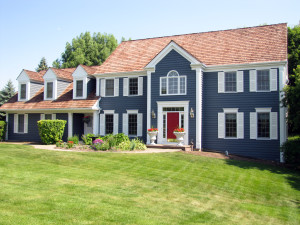Do It Yourself
Do It Yourself section has been designated for homeowners who want to paint their houses by themselves. They may wonder which path should be chosen to accomplish the job the most efficient way. These How-tos help to indicate right direction. Here are some tips and tricks about painting in form of question and answers:
What tape is better for painting? What color of tape choose for painting?
Yellow tape should be chosen for rough surfaces. It is 1-day tape only, which means the longer it stays on the surface the harder will be to remove it. Although, one-day rule can be extended in time a little. It should not be used on floors because its sticky surface has more glue. It’s perfect for varnished baseboards, baseboards which have very thin upper edge or tile baseboards like the ones in bathrooms or kitchens.
Blue tape is proper for smooth surfaces. It is 14-day tape, which means it’s more forgiven for later removal if we have to keep it on place longer.
It is good on:
-
glass – helping to paint for example windows
-
baseboards painted with semigloss – to avoid paint peeling off (if yellow tape would be used)
In general, tape should be pressed to the surface with a piece of fabric to eliminate air bubbles and to be sure the line is straight. Blue tape, with red color inside part of the roll, is designated for colors separation lines on walls.
What tape width for baseboards?
1-inch wide tape may be too narrow to protect baseboards and adjacent floors. 2-inch tape will bend down over time under gravitational force. 1.5-inch tape is the best to be applied on baseboards.
What type of paint is the best? Should I apply one or two coats of paint? Two coats with cheap paint vs one coat with expensive paint?
There are, in general, four types of situations:
Cheaper paint should cover well when applied flat on flat and a new color is not significantly different from an old color. Flat surface has better friction for application of a new paint.
Cheaper paint is usually more liquid so it will run down on slippery eggshell or semi gloss surfaces if it is applied too much. If the difference in shade between an old and a new color is not significant, then we can get away with one coat buying just a little more expensive Behr Ultra Plus, which is more like a yogurt than milk (like cheaper paints – Behr Ultra or Glidden) in order to save some money on material. (…)
The surface is flat but the difference between new flat color and old color is significant, then one coat of expensive paint should do the job.
The surface is glossy and the difference between new color and old color is significant, we can try to apply two coats of cheap paint, but carefully because it may run down – especially on overlapping brush/roller areas.
Expensive paint will do the job, two coats without running down.
Tip for two-coat application:
First coat should be thinner (done with “drier” roller), so we can reapply next coat sooner. It saves time and materials also.
Using drop clothes vs vacuuming
If we patch wall holes over floor it is better not to use drop clothes and vacuum the dust. We can just use softer side of wetted spounge to remove mud from the floor. If we have to patch wall holes over carpet it is easier to cover it with drop clothes, doing that this way will help us avoid (harder to achieve) carpet vacuuming.
How to clean paint brushes?
There is no need to clean paint brushes after work every day. Actually, it is not healthy either, due to inhaling paint vapors. Paint brush should be, at the beginning, submerged in paint, up to metal edge and wrapped in plastic, like for example shopping bag, just one if stored over night, two bags if stored for a few nights and more, because plastic is permable for air and brush bristles may dry up. Soap should be used to “glue” bristles together, which has to stay on it without water rinsing. Clean brush should be hanged upside down, there is a hole on the other end of it for that purpose.
How to patch?
Patching heavily damaged areas should be done with more but thinner layers (instead of fewer but thicker ones) because the mud dries quicker and we can touch them up faster. Also thinner layers save time and energy for sanding. In other words, it’s better to patch less but more times.
To prime or not to prime?
Priming may be in many cases not justified.
If we have to paint heavy smoker’s room, then priming is obvious.
Applying eggshell or semi gloss paint and fixing walls requires “priming” with the same finish. If we had used flat primer, for sure, we would have those areas exposed with different texture.
There may be quite opposite situation. Rough wall should be sanded with pole sander entirely, before painting, after spot fixing for texture equalization. If we has not done it, patched and sanded areas would be “too nice” and “too smooth” for the rest surface of that wall.
Paint Rollers: Wash or waste?
I recommend polyamide Purdy 9′ rollers. They are very easy to wash. It takes just few minutes to clean them (with spinning on a handle at the end, to get rid of the water). This is economy efficient and environment friendly solution. I usually wear mask, washing rollers to avoid paint vapors inhaling.
